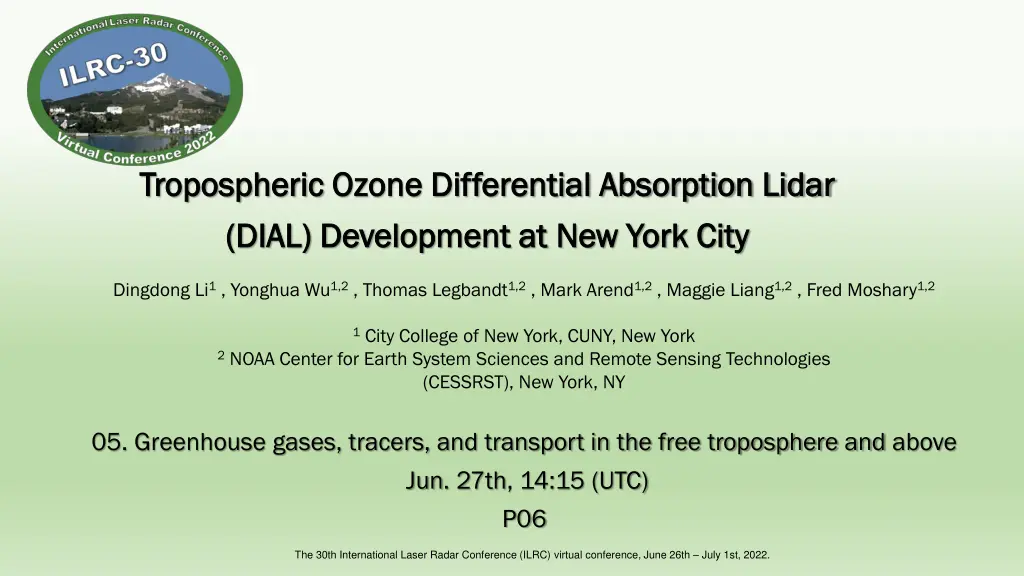
Development of Ozone Differential Absorption Lidar at New York City
"Explore the development of Tropospheric Ozone Differential Absorption Lidar (DIAL) in New York City, focusing on greenhouse gases, tracers, and transport in the free troposphere. The system utilizes advanced technology for ozone retrieval and provides valuable insights into ozone concentrations and trends. Results show consistency with ground observations, highlighting ozone pollution events and potential stratospheric ozone intrusions. Discover the intricate process of ozone number density calculation, molecular extinction, air density, and aerosol correction methods employed by this innovative system."
Uploaded on | 0 Views
Download Presentation

Please find below an Image/Link to download the presentation.
The content on the website is provided AS IS for your information and personal use only. It may not be sold, licensed, or shared on other websites without obtaining consent from the author. If you encounter any issues during the download, it is possible that the publisher has removed the file from their server.
You are allowed to download the files provided on this website for personal or commercial use, subject to the condition that they are used lawfully. All files are the property of their respective owners.
The content on the website is provided AS IS for your information and personal use only. It may not be sold, licensed, or shared on other websites without obtaining consent from the author.
E N D
Presentation Transcript
Tropospheric Tropospheric Ozone Differential Absorption Lidar Ozone Differential Absorption Lidar (DIAL) Development at New York City (DIAL) Development at New York City Dingdong Li1 , Yonghua Wu1,2 , Thomas Legbandt1,2 , Mark Arend1,2 , Maggie Liang1,2, Fred Moshary1,2 1 City College of New York, CUNY, New York 2 NOAA Center for Earth System Sciences and Remote Sensing Technologies (CESSRST), New York, NY 05. Greenhouse gases, tracers, and transport in the free troposphere and above Jun. 27th, 14:15 (UTC) P06 The 30th International Laser Radar Conference (ILRC) virtual conference, June 26th July 1st, 2022.
1 CCNY-Ozone-DIAL System Transmitter: Nd:YAG Laser (Quantel Q-Smart 450), 266 nm, 50 mJ, 20 Hz 1-m Raman Cell filled with CO2 of 10.3 bar. On -line: 287.2 nm, 10.6 mJ Off -line: 299.1 nm, 6.3 mJ. Receivers: Far-range telescope: 50-cm diameter, 1.5-mrad FOV, 510-m full overlap (simulated). Near-range telescope: 5-cm diameter, 4.3-mrad FOV, 120-m full overlap (simulated). Beam splitter: Omega Optical, >90% T @ 299.1 nm, >95% R @ 287.2 nm. Interference Filter: Alluxa, 287.2 nm and 299.1 nm (FWHM ~1nm, T ~ 35%, OD 5 blocking) Detectors: gated PMTs, Hamamatsu R9880U-113 Data Acquisition: Licel transient recorder (model TR40-16bit-3U, Ethernet), 40 MHz and 16 bits Analogy to Digital Converter, 800 MHz Max Photo- Counting rate, 25 ns time resolution. Fig. 1. Schematic diagram of CCNY O3-DIAL system. The 30th International Laser Radar Conference (ILRC) virtual conference, June 26th July 1st, 2022.
2 Ozone Retrieval 1. Ozone DIAL Equation: 2. Retrieval Procedures: Cloud Screening Ozone Calculation Aerosol Correction Signal Merge Pre-processing 1. Calculate ozone number density. 2. Calculate the molecular extinction and air density using the model data or radio- sound data. 3. Calculate the ozone mixing ratio. 1. Merge the near and far range analog signal for cloud screening. 2. Take derivative of Pz2 of the merge signal. 3. Identify the cloud base height. Merge the PC and analog signal profile. 1. Time average. 2. PC signal dead time correction. 3. Background subtraction. Calculate the aerosol correction terms with the ceilometer or aerosol lidar data. The 30th International Laser Radar Conference (ILRC) virtual conference, June 26th July 1st, 2022.
3 Result 04/29/2022 Ozone retrievals consistency from the near and far-range channels and comparison with ground obs. elevated ozone concentration around 7.5 km and above 8. km, which may be associated with stratospheric ozone intrusion in spring. Good consistency between the two channels at 0.9- 1.8 km Fig. 2. CCNY-DIAL ozone mixing ratio retrieval on April 29th 2022. (a) Ozone mixing ratio profiles from the far- and near-channel at 2022 April 29th 13:18:05 (EDT). (b)Time-altitude curtain plot of the near-far range merged ozone mixing ratio from 11:00-18:00 (EDT). (c)The comparison of DIAL-measured ozone mixing ratio at 250 m and ground ozone measurements.
4 Result 05/21/2022: An O3 pollution event on the hot day (air Tmax>90F) Good consistency and trend between the DIAL retrieval and ground in-situ obs. High ozone concentration (>70 ppb) within the PBL around 15:00 - 15:40 (EDT) The ozone mixing ratio from DIAL at 250 m altitude showed consistent temporal variation with the ozone mixing ratio from the surface ozone monitor.
5 Conclusion In this paper, we demonstrated a newly-built Ozone DIAL system at the City College of New York (CCNY). The DIAL uses a Nd:YAG laser pumping a CO2 Raman cell to generate the desired wavelengths at 287.1 nm and 299.2 nm. The receiver utilizes two telescopes that cover the near-range and far-range ozone measurement from near-surface to upper troposphere. We have made experimental observations and evaluated the O3 retrievals with the in-situ measurements. The results indicate consistent O3 retrievals in the upper PBL between the far-range and near-range channels. The O3 results at near-surface ( 0.25 km) show good agreement with the ground in-situ measurements under favorable weather condition. Our observations show aloft O3 layers in the free troposphere in NYC area, which might be associated with the regional transport from the wildfire smoke and/or the stratosphere-troposphere exchange, and high ozone concentration within the PBL during pollution events. These initial results show that the CCNY-Ozone DIAL is able to provide reliable ozone profiles in the troposphere. Currently, we are continuing the system optimization and regular experiments. The DIAL system will be moved into a trailer which allows mobile observation for the field campaign and inter-comparison with other ozone vertical measurements. Acknowledgements: This research was in part funded by the New York State Energy Research Development Authority (NYSERDA, grants #: 137482), NESCAUM (grant# 2417) and the NOAA under the CESSRST agreement NA16SEC4810008.
